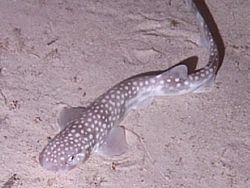Catshark
| Catsharks Temporal range: Upper Jurassic–Recent |
|
|---|---|
 |
|
| Whitesaddled catshark, Scyliorhinus hesperius | |
| Scientific classification | |
| Kingdom: | Animalia |
| Phylum: | Chordata |
| Class: | Chondrichthyes |
| Subclass: | Elasmobranchii |
| Superorder: | Selachimorpha |
| Order: | Carcharhiniformes |
| Family: |
Scyliorhinidae T. N. Gill, 1862 |
Catsharks are ground sharks of the family Scyliorhinidae. They are one of the largest families of sharks with around 160 species placed in 17 genera. Although they are generally known as catsharks, many species are commonly called dogfish or gato. Like most bottom feeders, they feed on benthic invertebrates and smaller fish. Despite being classified as a shark, catsharks are not harmful to humans.
The family includes 17 genera and over 150 species, making it the largest family of sharks.
Castsharks may be distinguished by their elongated, cat-like eyes and two small dorsal fins set far back. Most species are fairly small, growing no longer than 80 cm (31 in); a few, such as the nursehound (Scyliorhinus stellaris) can reach 1.6 m (5.2 ft) in length. Most of the species have a patterned appearance, ranging from stripes to patches to spots.
Characteristics of genus Apristurus are mostly dark bodies, having a long anal fin that ends in front of where the lower caudal fin begins. The snouts of the members of Apristurus are flat. They also present upper and lower labial furrows.
The sonic hedgehog dentition expression is first found as a bilateral symmetrical pattern and is found in certain areas of the embryonic jaw. Sonic hedgehog is involved in the growth and patterning of different organs. Every 18–38 days the teeth are replaced as is a common characteristic of the developmental process of sharks.
The "swell sharks" of the genus Cephaloscyllium have the curious ability to fill their stomachs with water or air when threatened, increasing their girth by a factor of one to three.
Some catsharks, such as the chain catshark are bioflourescent.
Catsharks are found around seabeds in temperate and tropical seas worldwide, ranging from very shallow intertidal waters to depths of 2,000 m (6,600 ft) or more, such as the members of genus Apristurus The Red spotted catshark lives in the shallower rocky waters ranging from Peru to Chile and migrate to deeper waters during the winter months. They are usually restricted to small ranges. Juvenile and adult chain dogfish live on the soft or rocky bottom of the Atlantic from Massachusetts to Nicaragua. Adults tend to live on the soft sandy bottoms possibly due to their need of egg deposition sites.
Some catsharks do not undergo long distance migrations because they are bad swimmers. Due to being nocturnal, some species sleep close together in crevices throughout the day and then go hunting at night. Some species such as the small spotted catshark, Scyliorhinus canicula, are sexually monomorphic and exhibit habitat segregation, where males and females live in separate areas; males tend to live in open seabeds, while females tend to live in caves. Some species of catsharks may deposit egg cases in structured habitats, which may also act as nurseries for the newly hatched sharks.
...
Wikipedia
